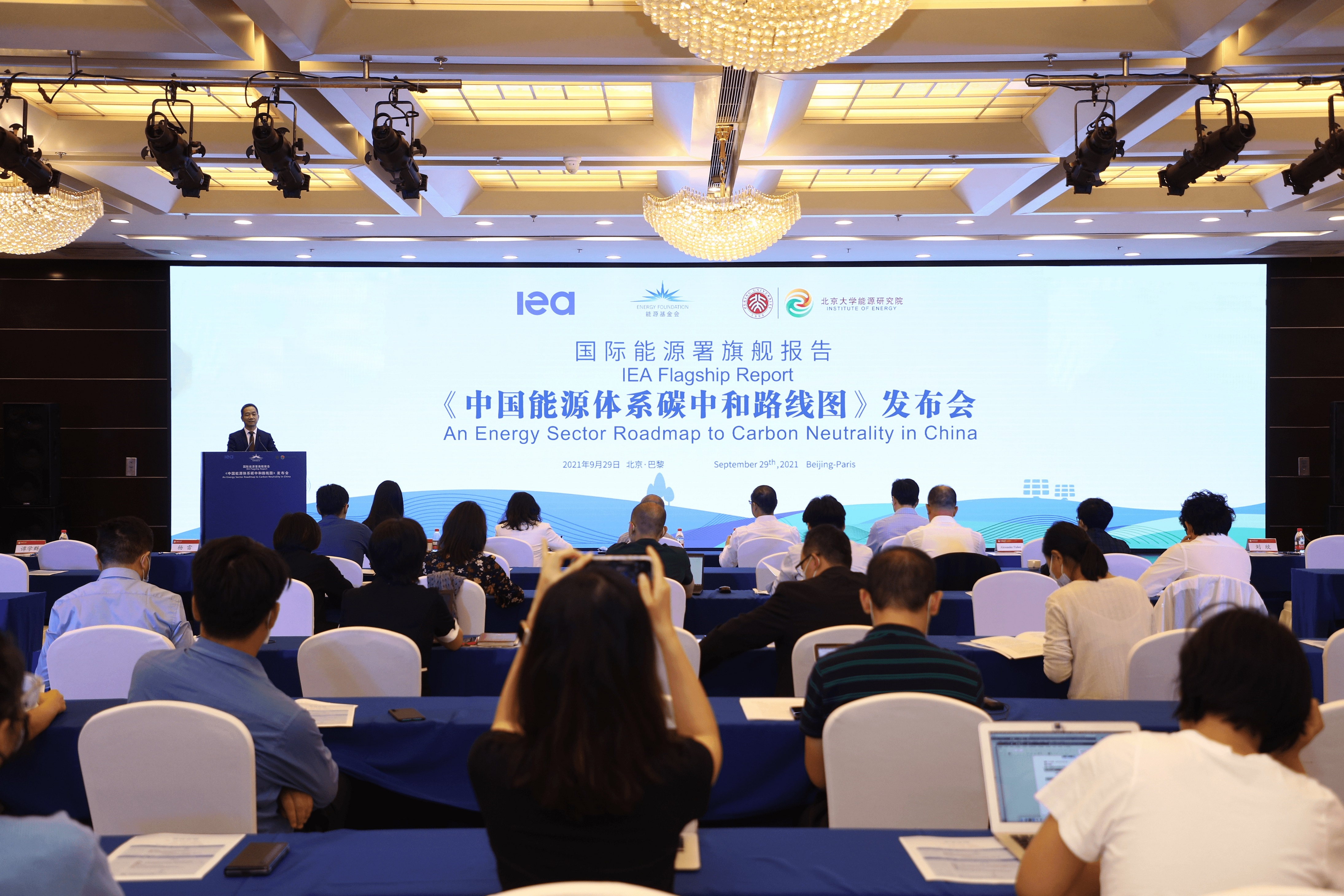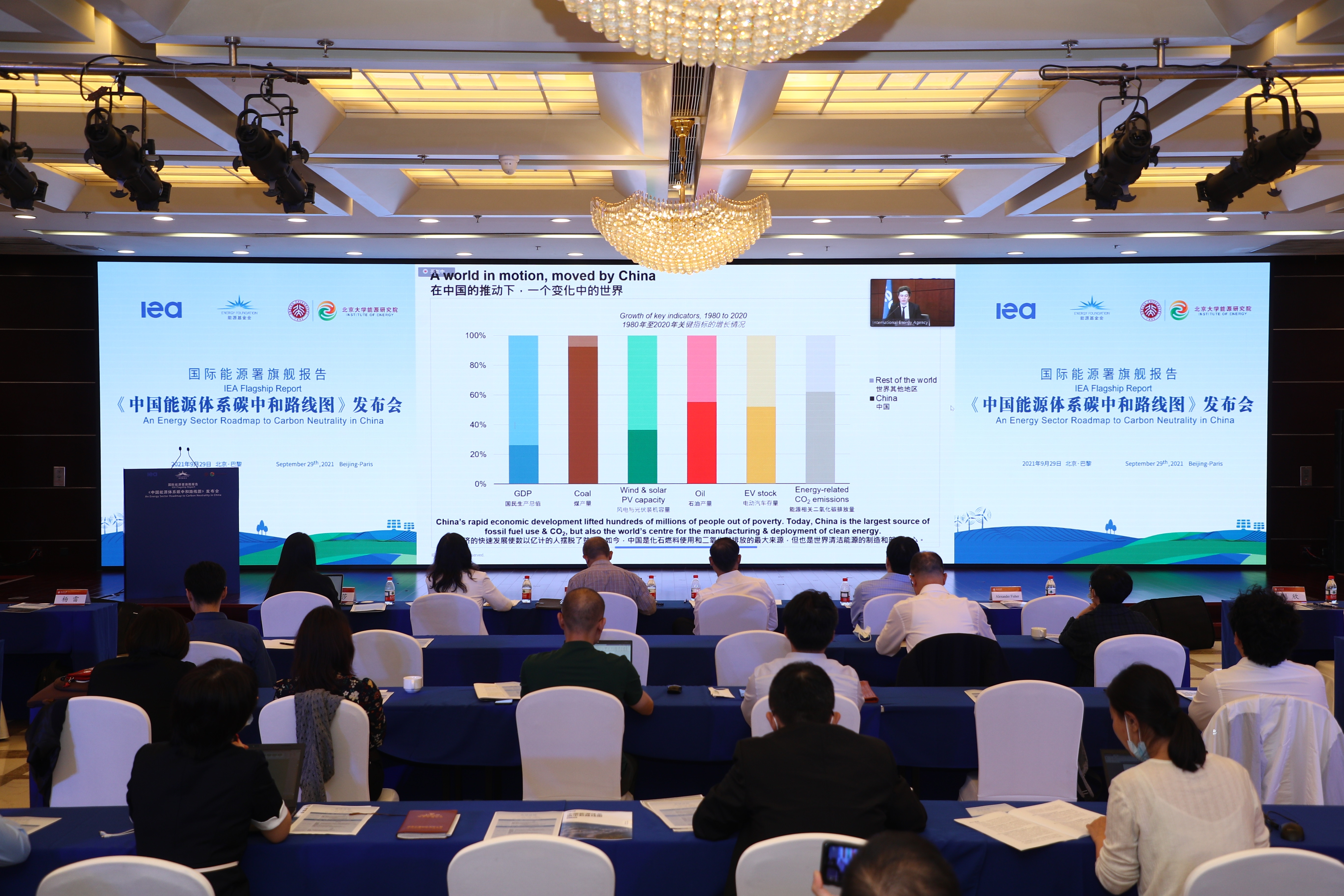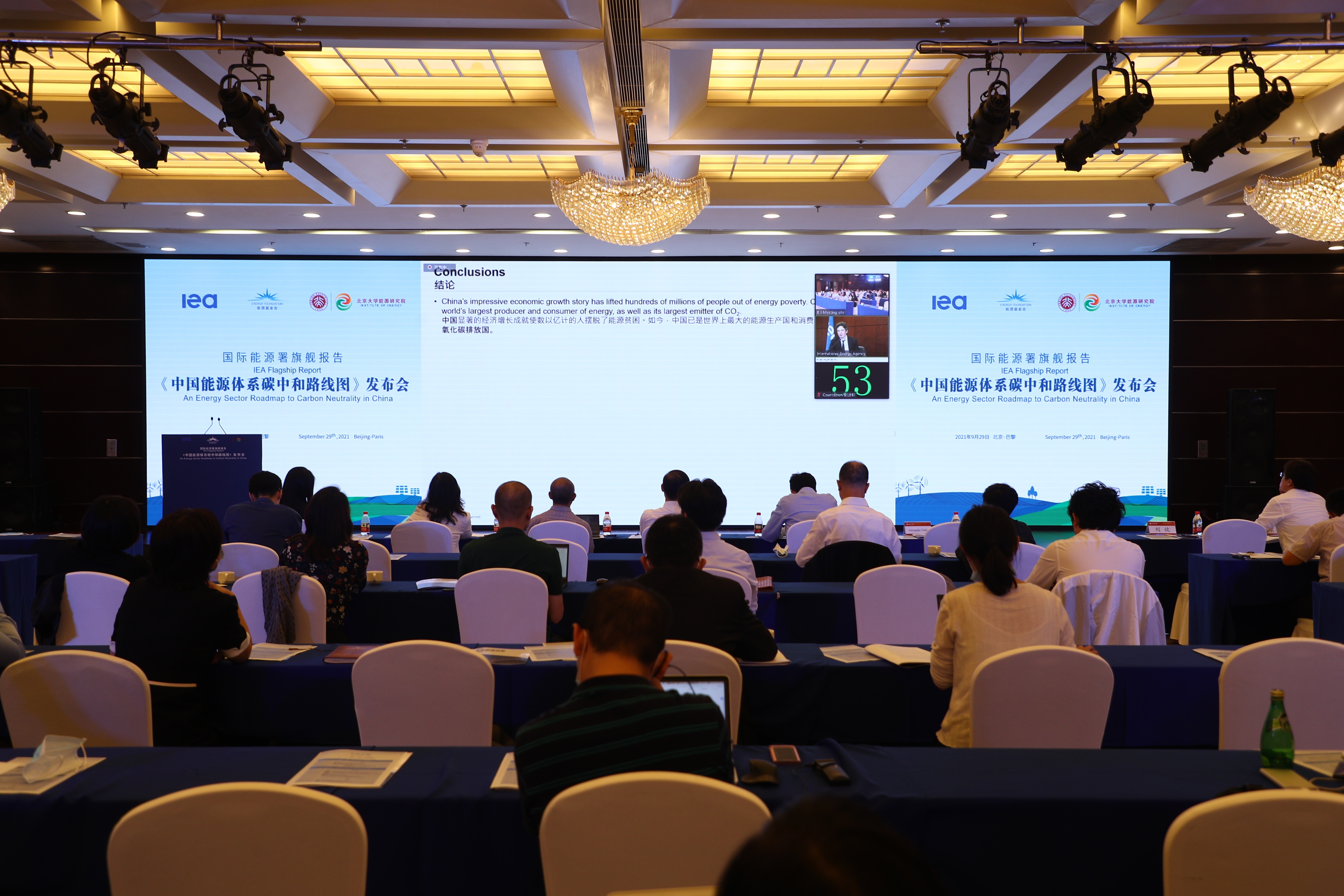IEA's flagship report :an Energy Sector Roadmap to Carbon Neutrality in China

On September 29, the International Energy Agency (IEA) flagship report "Carbon Neutral Roadmap for China's Energy System" was released in Beijing. The launch was co-organized by the International Energy Agency (IEA), the Energy Foundation (EF CHINA) and the Energy Research Institute of Peking University (IEPKU), and supported by China Energy News (CEN). The conference invited the IEA, relevant national ministries and commissions, some embassies in China, Chinese and foreign energy enterprises, experts and media to participate in a combined online and offline way, with more than 100 people attending the venue and over More than 650,000 people watched the event online in real time.
Dr. Fatih Birol, Director of IEA, Prof. Zou Ji, CEO and President of Energy Foundation China, and Academician Jin Zhijun, President of Energy Research Institute of Peking University delivered speeches, saying that the report is an important reference for our ongoing work on carbon peaking and carbon neutrality. Then Timur Gül, Director of Energy Technology Policy Department, International Energy Agency, gave a formal presentation of the report "Carbon Neutral Roadmap for China's Energy System".

The report was followed by a roundtable discussion in which Pan Jiahua, member of the Chinese Academy of Social Sciences and member of the National Expert Committee on Climate Change, Gao Shiji, Director of the Institute of Resources and Environmental Policy of the Development Research Center of the State Council, Chai Qimin, Director of the Strategic Planning Department of the National Center for Strategic Research and International Cooperation to Address Climate Change of the Ministry of Ecology and Environment, Jiang Liping, Vice President of the State Grid Energy Research Institute, Tsinghua University's Department of Earth System Science Professor and Deputy Head of Department Zhang Qiang and Araceli Fernandez Pales, Head of Technology Innovation Group, International Energy Agency (IEA) made comments, and Zou Ji and Fengquan An, Senior Advisor to the IEA Director, gave the conference summary. Lei Yang, Vice President of the Energy Research Institute of Peking University, and Sha Fu, Director of the Low Carbon Economic Transition Program and Director of Strategic Planning of the Energy Foundation, moderated the session and roundtable discussion, respectively.

The report notes that China has a clear path to a more sustainable, secure and inclusive energy future, and that by accelerating its clean energy transition, China can help bring the world closer to achieving common climate goals while securing key economic, innovation and employment benefits. Over the past four decades, China's remarkable economic growth has lifted hundreds of millions of people out of poverty and made the country a leader in many industries. But at the same time, China has become the world's largest carbon emitter, accounting for one-third of global carbon dioxide (CO2) emissions. China supplies more than half of the world's steel and cement, yet CO2 emissions from these two sectors alone are already higher than the EU's total carbon emissions.

China has committed to reach peak CO2 emissions by 2030 and carbon neutrality by 2060. The energy system is responsible for nearly 90 percent of China's greenhouse gas emissions, making energy policy central to the country's carbon neutral transition. A new report released today by the International Energy Agency - "A Carbon Neutral Roadmap for China's Energy System" - examines how China will achieve its low-carbon goals while ensuring energy security and affordability for its people. The report shows that given the size and dynamism of China's economy, the investments needed to achieve carbon neutrality are well within the country's capacity. The report responds to the Chinese government's invitation to the International Energy Agency to collaborate on long-term policy strategies.
Dr. Fatih Birol, Director of the IEA, said, "China is a major player in clean energy development, playing a leading role in many of the existing success stories, from solar power to electric vehicles. China's efforts to meet its carbon neutrality targets will foster a broader range of low-carbon technologies to flourish and drive significant reductions in the use of fossil fuels over the coming decades.
"But the really exciting news is that our roadmap shows that China has the means and capacity to achieve a more rapid clean energy transition, which will bring greater social and economic benefits to the Chinese people while also improving the world's chances of limiting global temperature rise to 1.5°C," added Dr. Birol. "This accelerated transition will result in a significant reduction in China's CO2 emissions after 2025, offering the possibility that China will be carbon neutral well before 2060. This has benefits for China and for the world."
China has made significant progress in its clean energy transition, but still faces some serious challenges. Coal currently accounts for more than 60 percent of electricity generation, and China continues to build coal-fired power plants in the country. At the same time, China has increased its solar power capacity year after year, more than any other country. China is the world's second largest consumer of oil, but it is also home to 70 percent of the world's electric vehicle battery capacity.
At the same time, achieving China's climate goals cannot rely solely on the promotion of renewable energy and electric vehicles, but will also require addressing the huge emissions originating from existing fossil fuel power plants, steel mills, cement kilns and other industrial facilities. If China's existing emissions-intensive energy infrastructure continues to operate in the same way, its CO2 emissions will account for one-third of the global carbon budget needed to control global warming by 1.5°C between now and 2060. This does not include the new plants that may be built to meet the growing demand.
This "China Roadmap" points to a path that is consistent with China's lofty goals announced last year to achieve peak carbon by 2030 and carbon neutrality by 2060. In this path, the main drivers of emissions reductions through 2030 will come from improving energy efficiency, developing renewable energy sources, and reducing coal use. From 2020 to 2060, renewable energy generation, primarily wind and solar photovoltaic, will increase sevenfold to account for nearly 80 percent of the nation's electricity mix. after 2030, industrial CO2 emissions will fall by nearly 95 percent by 2060 as emerging innovations such as hydrogen and carbon capture are strongly developed. These advances will boost China's labor market. The growing field of low-carbon energy technologies will create more new jobs than will be lost in the declining fossil fuel sector.
This roadmap also explores the opportunities and benefits of a faster clean energy transition in China. If China accelerates its transition, CO2 emissions will be 20 percent lower than current levels by 2030. In addition to the significant benefits of mitigating the effects of climate change, the social and economic benefits include the promotion of prosperity in regions that have not yet fully benefited from China's economic development, and the creation of additional jobs nationwide. The cumulative investment required for an accelerated transition is similar to that required for a slower transition, so the need for investment is not a barrier to an accelerated transition.

"This roadmap shows the possibilities that exist: China has a clear path to a more sustainable, secure and inclusive energy future," said Dr. Birol, "and will be making some important decisions in the coming weeks and months. The IEA is pleased to share our expert analysis and expertise from around the world with Chinese policymakers as we work together to build a brighter future. I welcome President Xi Jinping's announcement last week that China will stop building coal-fired power plants overseas as a new Chinese contribution to curbing global carbon emissions."

